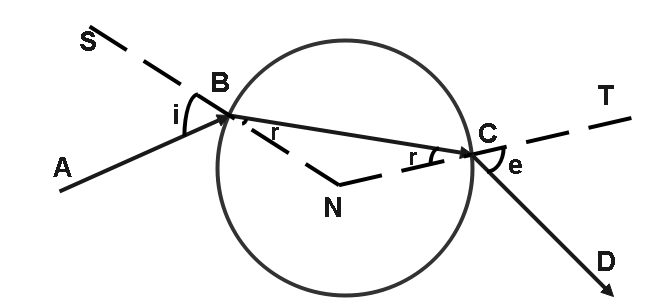
Answer
350.7k+ views
Hint: We want to determine the angle of incidence of a ray of light on a sphere of glass with refractive index $\dfrac{3}{2}$ so as to ensure that the ray of light does not come out of the sphere and by using Snell’s Law we will get the answer.
Formula used:
$\mu = \dfrac{{\sin i}}{{\sin r}}$
Complete step-by-step solution:
For the light to not come out of the sphere, $e$ must be greater than or equal to \[{90^ \circ }\].
Consider a ray of light $AB$ incident on the glass sphere at point $B$ at an angle $i$ . The angle of refraction is $r$ .

The refracted ray $BC$ comes out of the sphere at point at point $C$ and emerges from the sphere as ray $CD$ , with an angle of emergence $e$ .
Here we can see that $NS$ and $NT$ are the normal at the point of incidence and the point of emergence respectively and that $NB$ and $NC$ are radii of the sphere.
$ \Rightarrow \angle NBC = r = \angle NCB$
Also,
$\mu = \dfrac{{\sin i}}{{\sin r}}$
Where,
$\mu $ is known as the refractive index,
\[i\] is known as the angle of incidence and
$r$ is known as the angle of refraction.
And
$\mu = \dfrac{{\sin e}}{{\sin r}}$
$ \Rightarrow \sin i = \sin e \\
\Rightarrow i = e $
This means that, when a ray of light is incident on a sphere, the angle of incidence and the angle of emergence are always equal. If the ray of light should not come out of the sphere it means that the angle of emergence has to be at least ${90^ \circ }$ .
$\therefore $ The angle of incidence is ${90^ \circ }$ .
Hence, option (c) is the correct option.
Note: However, the angle of incidence cannot be more than ${90^ \circ }$ and if the angle of incidence is ${90^ \circ }$ , the ray of light will just brush past the sphere and will not enter the sphere. Refractive index is basically the speed of light in a medium with respect to air. Since we have speeds in both numerator and denominator, their units cancel out and thus the refractive index is unit less.
Additional information: The phenomenon happening here is known as refraction of light, this happens due to different speeds of light in different mediums. The medium in which the speed of light is more is known as rarer and in which it is less is known as denser medium.
Formula used:
$\mu = \dfrac{{\sin i}}{{\sin r}}$
Complete step-by-step solution:
For the light to not come out of the sphere, $e$ must be greater than or equal to \[{90^ \circ }\].
Consider a ray of light $AB$ incident on the glass sphere at point $B$ at an angle $i$ . The angle of refraction is $r$ .

The refracted ray $BC$ comes out of the sphere at point at point $C$ and emerges from the sphere as ray $CD$ , with an angle of emergence $e$ .
Here we can see that $NS$ and $NT$ are the normal at the point of incidence and the point of emergence respectively and that $NB$ and $NC$ are radii of the sphere.
$ \Rightarrow \angle NBC = r = \angle NCB$
Also,
$\mu = \dfrac{{\sin i}}{{\sin r}}$
Where,
$\mu $ is known as the refractive index,
\[i\] is known as the angle of incidence and
$r$ is known as the angle of refraction.
And
$\mu = \dfrac{{\sin e}}{{\sin r}}$
$ \Rightarrow \sin i = \sin e \\
\Rightarrow i = e $
This means that, when a ray of light is incident on a sphere, the angle of incidence and the angle of emergence are always equal. If the ray of light should not come out of the sphere it means that the angle of emergence has to be at least ${90^ \circ }$ .
$\therefore $ The angle of incidence is ${90^ \circ }$ .
Hence, option (c) is the correct option.
Note: However, the angle of incidence cannot be more than ${90^ \circ }$ and if the angle of incidence is ${90^ \circ }$ , the ray of light will just brush past the sphere and will not enter the sphere. Refractive index is basically the speed of light in a medium with respect to air. Since we have speeds in both numerator and denominator, their units cancel out and thus the refractive index is unit less.
Additional information: The phenomenon happening here is known as refraction of light, this happens due to different speeds of light in different mediums. The medium in which the speed of light is more is known as rarer and in which it is less is known as denser medium.
Recently Updated Pages
How many sigma and pi bonds are present in HCequiv class 11 chemistry CBSE

Mark and label the given geoinformation on the outline class 11 social science CBSE

When people say No pun intended what does that mea class 8 english CBSE

Name the states which share their boundary with Indias class 9 social science CBSE

Give an account of the Northern Plains of India class 9 social science CBSE

Change the following sentences into negative and interrogative class 10 english CBSE

Trending doubts
Difference Between Plant Cell and Animal Cell

Difference between Prokaryotic cell and Eukaryotic class 11 biology CBSE

Fill the blanks with the suitable prepositions 1 The class 9 english CBSE

Differentiate between homogeneous and heterogeneous class 12 chemistry CBSE

Which are the Top 10 Largest Countries of the World?

One cusec is equal to how many liters class 8 maths CBSE

Give 10 examples for herbs , shrubs , climbers , creepers

The mountain range which stretches from Gujarat in class 10 social science CBSE

The Equation xxx + 2 is Satisfied when x is Equal to Class 10 Maths



